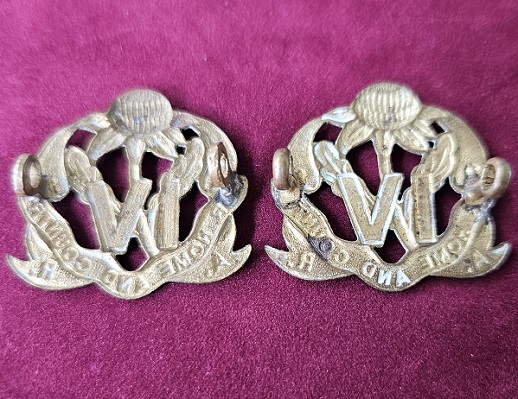Description
Description: 4th Battalion (Australian Rifles) – Brass Collar Badge Pair (1930-42).
Maker’s Name: Unknown
Condition: Very Good Plus
Comments: 4th Battalion (Australian Rifles) – Brass Collar Badge Pair (1930-42). Complete with 2 lugs.
After the First World War the defence of the Australian mainland lay with the part-time soldiers of the Citizens Military Force (CMF), also known as the Militia. The Militia was organized to maintain the structure of the First AIF and kept the same numerical designations. The 4th Infantry Battalion was designated the “Australian Rifles”, a regiment that had existed in various forms since 1908, with the 4th being raised in the 1920s. In 1930 the 4th merged with the 3rd Infantry Battalion to form the 4th/3rd Infantry Battalion. In 1933 the battalion was separated and the 4th again stood independently.
With Japan’s sudden entry into the Second World War and its military success in south-east Asia and the Pacific, the 4th was mobilised for full-time service in early 1942. In June it moved to Greta for further training, joining the rest of the 8th Brigade comprising the 30th and 35th Battalions.
The stay at Greta was brief and at the start of July the 8th Brigade moved to Western Australia. Over the next two years the brigade trained, laboured, and manned defensive positions along the coast from Bunbury to Geraldton. It was part of the 2nd Division, which made up III Corps with the 1st Armoured Division.
At the end of 1943 the brigade moved to North Queensland, via Sydney. In January 1944 the brigade, now part of the 5th Division, moved to New Guinea. Its role was to support the 9th Division’s Huon Peninsula campaign by clearing the Rio Coast between Sio and Saidor. The 4th Battalion was the first unit to arrive in New Guinea, relieving the 2/17th Battalion at Sio and moving forward. By the second week of February it had reached Saidor, having been relieved by the 30th at Crossingtown.
The next objective was Madang, where the 8th Brigade became responsible for the Madang-Bagadjim area. Staying on the coast and moving by foot and barge, the 30th occupied Madang and then Alexishafen, by the end of April. The 35th patrolled the inland mountain tracks. The 8th Brigade was based in the Madang area for the rest of the war. The 35th was concentrated south of the Rempi River, while the 4th was responsible for the area between Maclay River and Bostrem Bay.
In May the brigade was ordered to maintain pressure on the Japanese situated north of Alexishafen, in support of the 6th Division’s Aitape to Wewak campaign. The 35th moved to Megiar Harbour and sent out patrols to the coast, reaching Kronprinz Harbour and then Suara Bay, by early June. The 4th took over the advance and by mid-June occupied Bogia, Potsdam, and Hansa Bay. At Potsdam they located a group of 90 Chinese civilians who were captured at Madang and forced to work in vegetable gardens for the Japanese. Meanwhile, the 30th was based at Alexishafen, from where it sent out long-range patrols to Hansa Bay and the Ramu and Sepik Rivers.
In June the 30th was transported to Wewak, which had been captured by the 6th Division and was the site for a newly established Australian base. The 30th was responsible for defending the area between Mt Tazaki and Mt Shiburangu.
The remainder of the 8th Brigade was brought to Wewak in October, following Japan’s surrender and the end of the war. By the end of the year most of the brigade had returned to Australia. The last group left New Guinea on 24 January 1946 on board the transport ship Ormiston. The 4th was disbanded upon returning to Australia.






